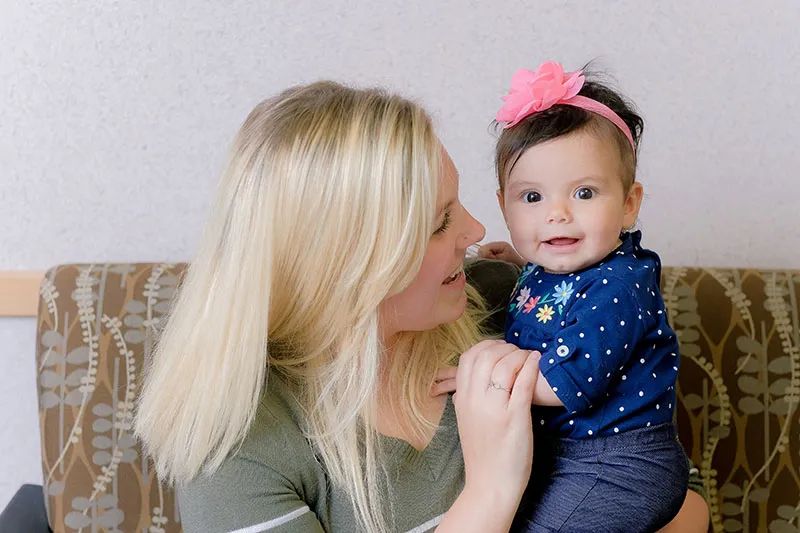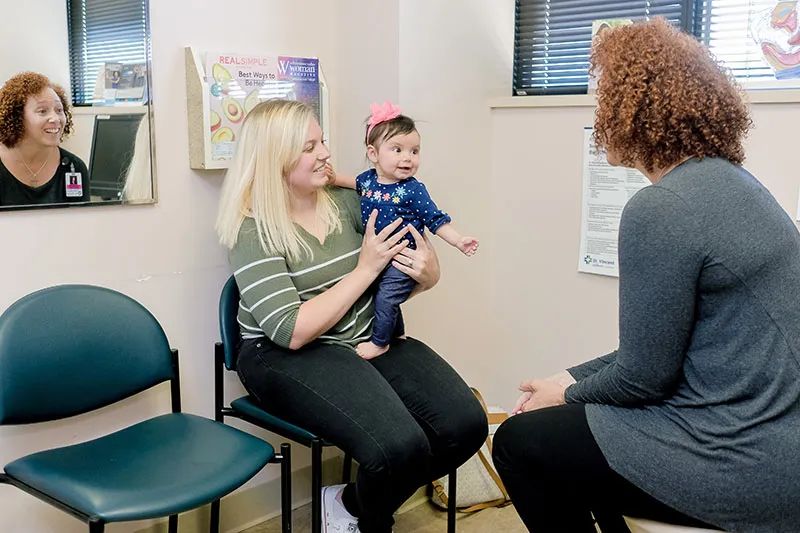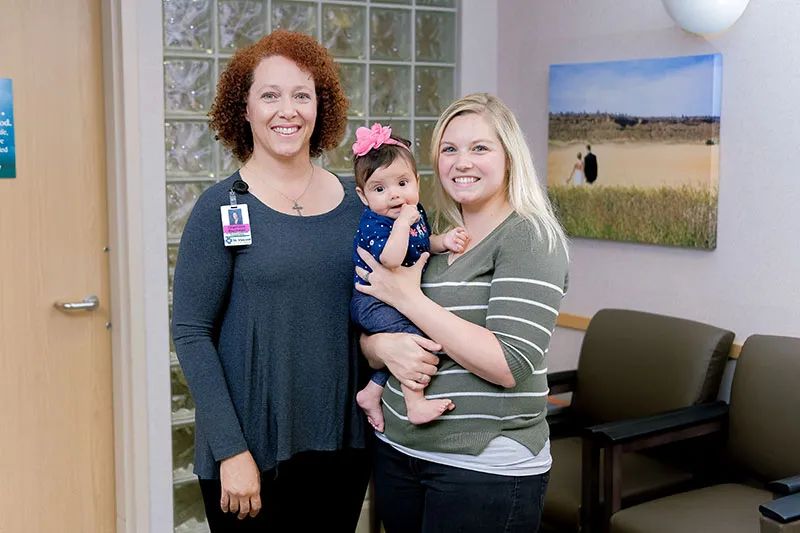
Third Time is a Charm
Billings woman is proof a VBAC is possible, even after multiple c-sections
Before 26-year-old Krischel Moran even felt the flutters of her third child inside the womb, she knew she and her husband, Luis, wanted this baby to come into the world differently. With two prior Caesarian section births, she did her research, hoping to make a plan to deliver her daughter naturally.
“Billings has an ICAN Chapter, which is the International Caesarian Awareness Network. I learned a lot from them, realizing VBAC (Vaginal Birth After Caesarian) is possible,” Krischel says.
She brought Chantielle Blackwell, her certified nurse midwife, into the conversation, and after doing a pretty extensive screening, Krischel got the green light. “I said, from then on, this is what I was going to do!”
“We know that women can birth babies,” Blackwell says. “We have been doing this since the beginning of time. It is really a buy-in on the woman’s part that she will believe her body will do it when it is time.”
When Krischel learned that she was a good candidate, she couldn’t help but reflect on the birth of her sons, Leandro, now 6, and Luca, who is 4.
“I had certain expectations,” this mom of three says. With her first, she says, “I went through the whole process of labor, pushed and everything and it just didn’t work out. I think I was so exhausted by the time I started pushing, I just didn’t have any energy left. My doctor also said my son was face up. I think that was a big factor in not being able to go any further.” Krischel’s labor ended with an emergency C-section.
With her second pregnancy, she says, “I got to about a week before my due date. I wasn’t showing any progress at all and that’s when my doctor said we should just schedule a C-section, just to avoid any complications.” She adds, “At that point, I should have had the knowledge. I wish I had a doctor who said, ‘It’s okay. We can keep trying with this. On my due date for my second child, I walked in without contractions and went straight into the operating room. I remember thinking that it was the most unnatural thing and I hated it.”

Blackwell, who works out of St. Vincent Physicians Midwifery and Women’s Center, says what many women don’t understand is that it is their body, their baby and their birth. “When we say, ‘Did you know there is another option?’, many women are surprised. It used to be the train of thought — once a Caesarian, always a Caesarian.”
Truth be told, for a majority of women, that’s not the case.
“Nationally, about 70 percent of women that attempt a vaginal birth after Caesarian will be successful. In this practice, we are a little over 90 percent,” Blackwell says. “I think it is because we are extremely patient and we really want to partner with our patients to let them know they can do this. They can totally do this. They just have to be patient.”
When a woman asks if a VBAC is possible, Blackwell says the first step is a thorough screening.
“The process means reviewing why there was a Caesarian to begin with,” Blackwell says. Was the baby in distress? Did it fail to descend? Was the mother exhausted? Blackwell says, “What was the actual indicator that said we need to go for a Caesarian? In Krischel’s case, her first was maternal fatigue and the second time around it was a scheduled C-section. That told me she was a great candidate.”
Aside from the C-section indicators, providers need to look at a woman’s incision. Is it a low transverse incision, basically, a cut right along the upper bikini line? Or, is it a classical incision, meaning more of a T-shaped cut across the uterus?

“If we have a lady who has a classical incision, the options are that we really need you to talk to your obstetrician and get a second opinion because it is not advisable when you have that large of an area that has been cut through the muscle. Those muscles heal a bit differently,” Blackwell says.
If all signs point to the chance of a successful vaginal delivery, Blackwell says she makes sure the mom understands the risks.
“We know that after one Caesarian that the risk of uterine rupture is anywhere from .5 percent to 1.5 percent,” Blackwell says. “We don’t have good statistical data to say exactly what the percentage of risk is for women with two prior C-sections, but we know it is greater than one. We counsel our patients and tell them that yes, there are risks involved.” Blackwell says uterine rupture is the number one threat. “When that happens, it means the area of the uterus that has been weakened by an incision from a prior Caesarian opens. The uterus is no longer completely enclosed. You can lose blood, and in this case, losing blood, depending on the amount, could be lethal for baby and mom.”
It’s the precise reason why, when one of Blackwell’s patients with a prior C-section goes into labor, she does it right across the hall from the operating room. Blackwell keeps a constant eye on how the baby is doing, every step of the way.
“When we are looking at fetal heart tracings, the baby is communicating to us how well things are going on inside. And so, when a baby says to us, ‘Hey, I am not liking what is going on in here and I am kind of feeling like I am not getting what I need. I kind of want to come out right now and I mean right now.’ That means, we get to go to the operating room,” Blackwell says.
Thankfully, that wasn’t the case for Krischel. At 41 weeks and five days, even though she was tempted to just wave the white flag and schedule a C-section, she went into labor on her own. While Blackwell did have to augment with a small dose of Pitocin, a contraction-inducing drug, her labor kept on moving.
“She just needed to relax and trust that this was going to happen,” Blackwell says. “Lo and behold, before we knew it, it was time to have a baby.”
On Jan. 6, Krischel and Luis gave birth to Kamila, a 7-pound, 7-ounce healthy and beautiful baby girl with saucer-shaped brown eyes and a full head of hair. Since that day, Krischel has championed the VBAC cause for other women. She’s shared her story on social media and chatted with other women considering the same birth plan.
“There were a couple of women who said hearing that it was successful for me, they felt they could do it as well. They felt like they had the power to make it happen too,” Krischel says. “I felt like this is what it means to be a woman, to be in control of how it is supposed to happen.”
WHY CONSIDER A VBAC?
You’ll more than likely have a shorter stay in the hospital than if you had an additional C-section.
Moms get to participate more in the birth of their child
Reduce the risks tied to multiple Caesarian deliveries
YOU MIGHT BE A GOOD CANDIDATE IF…
You have a low transverse uterine incision
Your pregnancy isn’t considered high risk
Your reasons for having a prior C-section are no longer factors
You had a previous successful vaginal delivery
ENHANCING THE CARE EXPERIENCE
Saint Vincent Healthcare Saints Ball 2018
On October 6, St. Vincent Healthcare Foundation will present the 40th Annual SAINTS 2018. This premier fundraising event benefiting the healing ministry of St. Vincent Healthcare brings an evening of dining, dancing, along with a variety of auction items up for bid. This year’s funds will help give a fresh appearance to the St. Vincent Healthcare Birthing Center. The funds raised will:
Create 12 state-of-the-art, family-friendly birthing suites along with 3 additional triage rooms
Provide maternal amenities like whirlpools, birthing balls, an extra bed for the mom’s partner along with new entertainment options
An enhanced and soothing environment with updates to the rooms’ décor
Large family waiting room with additional seating areas within the suites and throughout the unit
For more information on this campaign or to purchase tickets for the Ball, please contact Heather Bergeson at (406) 237-3638.











